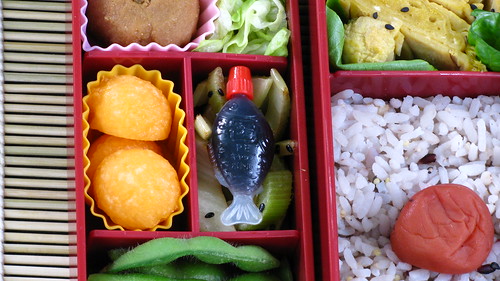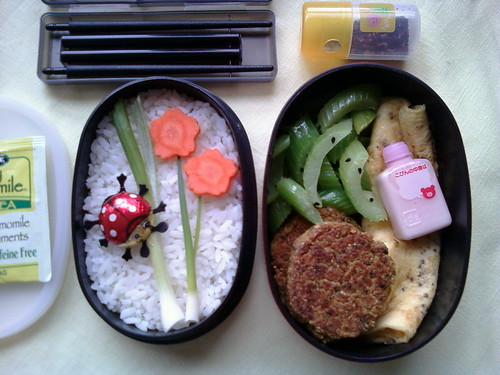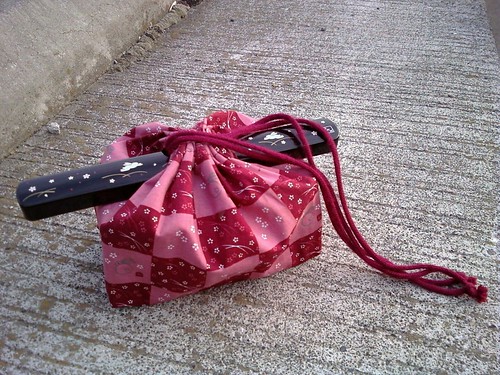In which this is a quick primer for all y’all who are innarested in packing your own lunches all healthy and cute-style.
Matro said this, so I’m saying this:
Bento boxes are nothing more than lunch boxes that happen to be from Japan, so you can put non-Japanese food into them if you want (and I do all the time). They are compact, visually appealing, and reusable. They have a variety of accessories, including chopsticks, fork and spoon sets, sauce bottles, food cups, picks, food dividers, carrying bags, and more.
The volume of a bento box is expressed in ml, and for some bizarre reason food ends up averaging roughly one calorie per mililiter of volume. This means that if you buy a 970ml bento box and you fill it up with food, you’re going to find that you’re having about a 970 calorie lunch. (On average. If you pack the thing with solid cheese, it’ll be more than if you pack it with watermelon, of course.) The ml-per-calorie thing is ballpark, a guideline, and assumes a well-balanced variety of items in the box, including starch, protein, veggies, and fruit.
I mention this because if you don’t work construction, you probably don’t want a thousand-calorie lunch, so you want to pay attention to a box’s volume when shopping online. Women’s boxes should run a little over 500ml; men’s boxes can run quite a bit bigger, which is fine if the man is active or wants his lunch to be his largest meal. Watch out, though, if you’re a desk jockey and buy a huge box! Bento boxes should seem small; you’ll see why when you read about how they’re supposed to be packed.
The traditional Japanese method of packing a bento box is to fill about half the box with rice, then add primary okazu (basically, “what you eat with your rice”) and secondary okazu (side dishes), to fill, and then decorate if desired. The ratio is, traditionally, 4:2:1 (or four parts rice, two parts protein, and one part other stuff). The box should be full enough that the contents don’t move around during transport, so you’ll be using every one of those mililiters!
Bento lunches are eaten at room temperature, which is why they traditionally contain foods that are spoil-resistant – preserved, salted, pickled, or citrus. (I find that nearly everything tastes just fine at room temperature, and very rarely bother to nuke my bento.) Note that while some boxes can be nuked, most can’t. Oh, and many of the thermal sets do not keep food hot at all, because Japanese customers don’t really expect them to.
Many boxes are sold alone, but if you shop carefully you can find entire sets – bento box, cutlery or chopsticks, carrying bag or furoshiki, and sometimes even a drink bottle – sold together for a very reasonable price. If you’re getting your first box, I’d recommend that route because it makes for a more satisfying mail day.
Instead of buying paper food cups to go into your bento box, try silicone muffin cups instead. They’re reusable and come in a variety of sizes and colors, and will keep your dry foods away from your saucy foods.
Definitely get a package of those tiny sauce bottles. They’re wonderful. You can use them for soy sauce, salad dressing, hot sauce, or even chili oil, and I find that they add a great deal of pleasure to a meal that might otherwise just be a cute box stuffed with boring leftovers.
Link Pr0n!
General:
How-to:
Where to buy boxes:
Japanese recipes:
- Japanese rice
- Onigiri (rice balls)
- Soboro (meat)
- Tamagoyaki (egg)
- Kinpira
- Side dishes and space fillers
- Miso
- furikake (rice sprinkles)
Pictures of amazing bentos and Flickr bento groups:
- Garden bento
- Little wooden bird bento
- Boy playing flute bento
- Totoro bento
- Death Star bento
- Tatooine bento
- Wall-E and Eve bento
- HAPPY and FRESH BENTO (group)
- Just Bento (group)
I bento because it’s good on a variety of levels. Sure, at the end of the day a bento box is just a lunch box, but unlike huge, ugly Western lunch boxes (or baggies and brown bags, or stacks of inelegant, disposable Gladware), bento boxes actually cause me to use them.
Bentoing is cheaper than eating out. It tends to make you use up tiny leftovers that you’d otherwise throw out or allow to rot in the fridge. Depending on how you cook, it can be several orders of magnitude more healthy than eating commercially-prepared food. It keeps a shitload of paper and plastic and styro out of your local landfill. It can get you involved with what, why, and how you eat. It can be a great diet-control tool. Not to mention that there are senses that are engaged and nourished when presented with good food, attractively presented.
Want to start taking your lunch to work? Buy yourself a bento box. Seriously. You’ll get such a kick out of your own lunches that you won’t even be able to stand yourself. Do it!
Disclosure: Yes, I own every single box pictured in this post. Um.
3 Responses to Bento strategery.
Leave a Reply Cancel reply
Friends
- Barn Lust
- Blind Prophesy
- Blogography*
- blort*
- Cabezalana
- Chaos Leaves Town*
- Cocky & Rude
- EmoSonic
- From The Storage Room
- Hunting the Horny-backed Toad
- Jazzy Chad
- Mission Blvd
- Not My Rabbit
- Puntabulous
- sathyabh.at*
- Seismic Twitch
- Stevers
- superherokaren
- The Book of Shenry
- The Intrepid Arkansawyer
- The Naughty Butternut
- tokio bleu
- Vicious, Unrepentant, Bitter Old Queen
- whatever*
- William
- WoolGatherer
- zigzackly
















Very most excellent. So going to get started in the wonderful world of bento and start having a happier (i.e., not vending machine) lunch… I’ll let you know which set I wind up with (and the ml/cal thing is a great guideline). Thank you!!
Boo vending machine lunches! Yay bento!
Mush is my bento queen. Lunch on!
Yay my editor, who makes me write articles on bento for the paper! -m